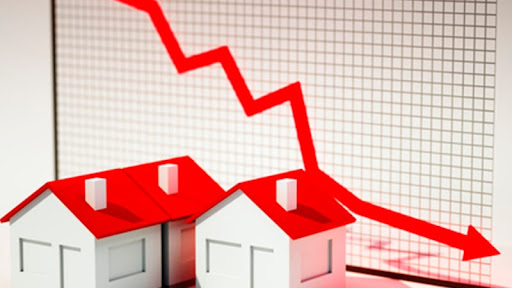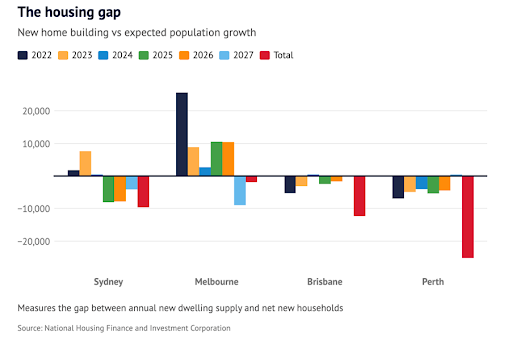
Australia is heading towards a severe housing crisis, with a projected shortage of 106,000 homes by 2027.
This dire situation arises from high-interest rates, surging immigration, and community resistance to new developments.
Despite a recent 0.6% increase in dwelling values in March, the National Housing Finance and Investment Corporation (NHFIC) warns that cities like Brisbane and Sydney will each face a shortage of over 10,000 homes within the next five years.
Currently, the country is grappling with housing pressures, as evidenced by rental vacancy rates below 1% in every capital, construction delays and growing costs, and slowed building periods due to bad weather in 2022.
The recent collapse of a number of prominent builders has only exacerbated the issue.
The NHFIC predicts that only 148,500 new dwellings will be added to the national housing stock this financial year, with a further decline to 127,500 in 2024-25.
The largest drop is expected in apartments and multi-density dwellings, with an estimated net of 57,000 homes built annually over the next five years – a 40% decrease from the late 2010s.
One significant factor driving demand is high net migration, predicted to reach 350,000 this year as overseas workers and students return to the country.
However, supply is falling due to the limited availability of serviced land, high construction costs, faster-than-anticipated rise in interest rates, and persistent community opposition to new developments.
NHFIC CEO Nathan Dal Bon warns that the combination of strong demand and low housing supply will burden the market for years, particularly impacting renters.
"The rapid return of overseas migration together with a supply pipeline constrained by decade-high construction costs and significant increases in interest rates is exacerbating an already tight rental market," he said.
Perth is expected to experience the most significant shortfall, with a predicted shortage of 25,200 dwellings.
Sydney's forecast has shifted from a surplus of 16,900 dwellings to a shortfall of 9,600.
Melbourne's shortfall has improved slightly from 6,200 to 1,900, while Brisbane's situation has worsened from a forecasted surplus of 3,300 to a deficit of 12,300.

The pandemic has also influenced demand, as an additional 341,500 households have been formed since mid-2021.
People are increasingly opting to move out of shared homes or family residences to live independently.
Housing Minister Julie Collins, who is striving to gain Senate support for the government's $10 billion Housing Australia Future Fund, emphasizes that the report underscores the urgency for more action on housing.
"This report is another reminder that too many Australians are struggling to secure safe and affordable housing," she said.
Our housing markets are moving to the next phase of the cycle
The release of the report coincided with all the major research houses reporting an uptick in Australian dwelling values over the month of March.
Dr Andrew Wilson’s My Housing Market reported the national housing market has continued to strengthen over March following its revival in February, with quarterly house prices now rising for the second consecutive month.
According to Wilson, the national capital city's quarterly median house price increased by 0.8% over March compared to the February result – rising to $1,013,474.
CoreLogic’s national Home Value Index posted the first month-on-month rise since April 2022, up 0.6% in March.
Sydney, Melbourne, and Perth experienced growth in house values by 1.5%, 0.6%, and 0.5%, respectively.
And PropTrack reported that national home prices were largely stable in March, rising slightly by 0.13%.
They suggest a cumulative increase in 2023 is now 0.49%.
Proptrack Senior Economist Eleanor Creagh believes the end of interest rate rises are in sight and explained that limited supply, along with strong migration and higher rents, are underpinning property values.
What’s the solution?
The looming housing shortfall highlights the importance of collaboration among government agencies, private developers, and community organizations to find sustainable solutions to Australia's housing challenges.
Policy-makers must focus on addressing key issues like land availability, construction costs, and interest rates, and fostering community support for new developments.
To increase land availability, urban planning strategies should be developed to facilitate the efficient use of available land and encourage urban regeneration.
Infill development and land reclamation projects can help optimize land use in high-demand areas.
Additionally, the government should consider reviewing and revising zoning regulations to promote higher-density developments in strategic locations, enabling more efficient land use and the creation of diverse housing types that cater to different income levels and household sizes.
To cater to the influx of immigrants and overseas students, the government should also work on developing policies that support the construction of affordable housing specifically designed for these groups.
This could include the provision of incentives for developers to create purpose-built student accommodations or subsidized housing for temporary workers.
Interest rates, though largely determined by market forces, can be influenced by monetary policy decisions.
The Reserve Bank of Australia, in collaboration with the government, can work towards striking a balance between maintaining economic stability and ensuring affordable borrowing rates for homebuyers and developers.
In conclusion…
Australia is staring down a severe housing crisis.
The projected shortfall of 106,000 homes by 2027 calls for immediate and decisive action.
High-interest rates, increased immigration, and community resistance to new developments are among the challenges to be addressed.
Without a comprehensive and holistic approach to tackling these housing pressures, Australians will continue to face difficulties in securing safe and affordable homes.
